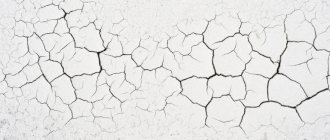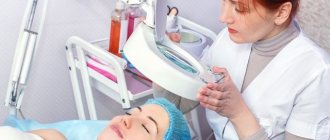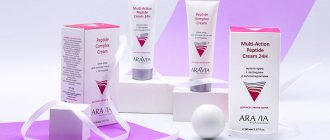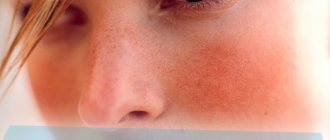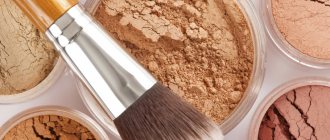Moisturize and nourish
Elena Kovtunova : Not only the face, but also the neck needs to be moisturized and nourished with cream. At the same time, remember that during the heating season it is better to switch to fatty, heavy textures. What does this mean? If you have normal skin, use a cream for dry skin. If you have oily skin, use a cream for normal skin.
And one more important nuance: you need to use the cream at least 40 minutes before leaving the room to go outside, or even better - an hour. At the same time, apply the cosmetic product to damp skin.
When is the best time to start cosmetic rejuvenation of the neck skin?
Unfortunately, it is impossible to stop the aging of the body, but you can do everything to slow down this process as much as possible. To do this, follow a proper diet. Eat vegetables, fruits (emphasis on those with a lot of vitamin C), cereals, dairy products, whole grain bread. Do not neglect gymnastics against wrinkles and the appearance of a double chin. In short, spend enough time on the health of your skin and, in particular, the areas around the neck and décolleté.
Peeling
Elena Kovtunova : A cosmetologist will always tell you which peeling is best to choose. In my opinion, preparations based on trichloroacetic acid, or Jessner peeling, have a good effect. The only important nuance is that after the procedure, the skin needs to be well moisturized, because all peels dry it out greatly. The number of necessary procedures is 3-4, once every 10 days. You can repeat the course after about six months.
Everything sagged. 6 habits that will make you an old lady before your time Read more
Buying the right pillow
Olga Malakhova : It is necessary to monitor the health of the neck not only during the day, but also at night. This is why it is so important to purchase an orthopedic pillow. This will help maintain proper head position while sleeping on both your back and side. At the same time, I note that it is best to sleep on your back. Then the muscles and skin of the face will be relaxed and distributed horizontally. If you sleep on your side or stomach, you cannot achieve a similar effect; moreover, these positions provoke the appearance of wrinkles and creases.
Question answer
Is biorevitalization suitable for women after 50 years of age?
Ice
Have you ever heard of ice cube therapy? When it comes to beauty care, don't forget about natural products.
Try using ice therapy on your neck 3 times a week. To do this, you will need to put three ice cubes in a scarf and massage your neck with them. The procedure will take you only 10 minutes. This will allow you:
- Activate blood circulation in the neck area
- Calm inflammatory processes
- As a result, your neck will restore its tone and begin to look more attractive.
Well, would you like to try one of these procedures today? Remember that we have the power to preserve the beauty of the neck and protect it from age-related changes.
It's never too late to take a step towards change!
In youth, few people think that the time will come and the skin will become flabby, inelastic, and wrinkles will appear. Therefore, not every woman provides her skin with proper care in her youth and adulthood, hoping that her beauty will last forever. This can lead to premature aging of the skin of the face, neck, and the appearance of early folds. If you notice that the first wrinkles have appeared, immediately give your skin the attention it deserves. Rejuvenating face masks will help tighten the skin, make it more elastic, delicate, soft.
Biorevitalization
Elena Kovtunova : The essence of this procedure is that you are injected subcutaneously with hyaluronic acid. It provides very good skin hydration and also stimulates cells due to mechanical trauma with needles. The procedure is quite painful, but if you apply anesthesia with application creams, you will feel almost nothing.
There are two types of biorevitalization: short-acting and long-acting. The choice of one or the other depends on the structure of the skin. For example, for young girls, short-acting drugs that are administered using the papular technique are better suited.
Naturally, biorevitalization needs to be done in a course. If we are talking about long-acting drugs, then this is three procedures every month and a half. This is enough for about six months. Naturally, this course will cost much more than if we used a short-acting drug.
Article on the topic
Watch your face. Habits that will help you maintain beauty
Peeling options: neck, décolleté and chest
In solving the problems of age-related skin changes in the neck, décolleté and chest areas, one of the most common and effective procedures is peeling (read more about what peeling is and how it works - read here). However, there are some peculiarities when performing it in these areas.
Currently, peelings are one of the most effective procedures in cosmetology and aesthetic medicine. They are classified according to the level of damaging effect into 4 groups:
— superficial (damage at the level of the stratum corneum);
- superficial-median (damage to the epidermis to the basement membrane);
- median (damage to a significant part of the basement membrane):
— deep (damage at the level of the middle dermis).
Features of delicate areas
Neck
The skin on the neck is very thin and lacks its own subcutaneous fat. Just under the skin is a thin muscle that is fused to the skin in places. This muscle is called the platysma. Platysma is a facial muscle and is involved in the process of lowering the corners of the mouth, and is also a depressor of the lower third of the face. She takes part in articulation and chewing. With age, the platysma quickly becomes flabby, which leads to sagging skin and the appearance of wrinkling, like wrinkled paper.
The skin of the neck is much less well supplied with blood than the skin of the face and also contains fewer sebaceous glands. That is, the skin in this area receives less nutrition and protection, but at the same time experiences almost the same stress. The level of photodamage to the skin of the neck is usually lower than that of the face and décolleté, since it is located at a very acute angle to the sun's rays and is partially covered by the lower jaw.
Cleavage
In this area, the skin is much thicker than on the surface of the neck and has pronounced subcutaneous fat. The muscle load here is weak. Wrinkles are formed, as a rule, in the area between the mammary glands, as they descend. The skin in the décolleté area is poorly supplied with blood, so damage takes a long time to heal with the formation of pronounced scars and hyperpigmentation (read more about remedies against hyperpigmentation here). In the summer, this zone is often exposed in women and tilted at an angle close to direct in relation to the sun's rays, therefore it is subject to severe photodamage and, as a result, the formation of hyperpigmentation and solar elastosis.
Breast
The skin in this area is thin, has poor blood supply, and stretch marks are common after pregnancy (see the article about what stretch marks are and how to get rid of them). With a loss of volume, the soft tissue quickly becomes flabby, and with an increase in volume, it quickly overstretches. The area is almost always covered by clothing, so photodamage is rare.
Peeling and general recommendations for its implementation
Blood circulation in these areas is reduced, and the skin does not recover well after damage. Therefore, to correct involutional changes in the neck, décolleté, and chest areas, superficial peels are mainly used (in the peeling section you can see the peeling products presented). Sometimes a light superficial-medium peeling can be performed. Medium and deep peels are fraught with complications - very often post-peeling hyperpigmentation and sometimes scars occur.
Among superficial peels, classic glycolic peeling can be put in first place (read here about glycolic acid and peels with glycolic acid). Glycolic acid is the smallest molecule of all alpha hydroxy acid molecules, so it can penetrate the deepest into the skin. In addition, in addition to the superficial damaging effect, glycolic acid also has a deep stimulating effect. Studies show that when applied externally, products with glycolic acid reach the dermis in a therapeutic concentration and have a stimulating effect on fibroblasts, and also significantly stimulate blood circulation in the skin. Histological studies have shown that glycolic acid can increase the production of collagen and hyaluronic acid in the dermis, as well as renew the epidermis. That is, classic glycolic peeling allows you to have a moderate or mild damaging and deep stimulating effect. For the skin of the neck, décolleté and chest, this is the most suitable combination. The skin of the body surface, including delicate areas, does not allow glycolic acid to pass through easily. Therefore, it is necessary to choose peeling solutions containing free (not buffered) glycolic acid.
Specifics of peeling solutions
What parameters of the peeling solution implement one or another effect of glycolic acid?
The concentration of glycolic acid is marked in %. Concentration:
— 20-25% — low,
- 30-40% - average,
— 50-70% — high.
Determines the strength of cell stimulation (depending on the depth of penetration) and partly its damaging effect. The acidity of the peeling solution is expressed in pH units (the lower the value, the higher the acidity). Acidity determines the depth of penetration of glycolic acid, the strength of irritation and most of the damaging effects. At very high acidity, glycolic acid acquires a direct keratolytic effect.
— pH 3.0-2.0 — low acidity,
— pH 2.0-1.5 — medium,
— pH 1.5-1.0 — high,
- pH below 1.0 - very high.
As you can see, the same property of glycolic acid is determined by different parameters of the peeling solution. Therefore, a comprehensive assessment of the strength of the peeling solution is necessary, which includes the synergistic relationship between acidity and concentration. Classic peeling solutions are presented in a parallel increase in the concentration of glycolic acid and acidity (decrease in pH) of the peeling solutions:
- AHA concentration less than 35% and pH above 2.0 - weak solutions.
- AHA concentration 50-35% and pH 2.0-1.5 - average.
- AHA concentration 50-70% and pH 1.5-1.0 - strong.
- AHA concentration 70% and pH below 1.0 - super strong.
Preparing for peeling
Pre-peeling preparation of delicate areas is not necessary, but desirable. For this, you can use a cream or lotion containing glycolic acid in an AHA concentration of 8-20%. A single application in the evening is sufficient. Pre-peeling preparation is carried out 5-8 days before each peeling procedure. To enhance the result, you can use a target serum or emulsion under a product with glycolic acid. This could be a serum with hyaluronic acid to enhance the moisturizing effect or a serum with retinol palmitate 0.15% to stimulate collagen synthesis. Emulsion with vitamin C 10% is recommended for use for depigmenting purposes (whitening cosmetics are also used to remove age spots), as well as to stimulate collagen synthesis.
Carrying out the peeling procedure
The procedure can be performed either together with a facial peeling procedure or independently.
We pre-treat the skin with special cleansers to remove sebum. Cleansing is not carried out as thoroughly as on the face, because in these areas there are no pronounced pores. We wash off the cleanser and be sure to dry the skin thoroughly with a paper towel. If the procedure is carried out together with facial peeling, then cleansing of the delicate area is carried out immediately after cleansing the face (you can see all skin cleansing products here).
We begin to work with medium-strength peeling solutions. Using a brush, apply the peeling solution to the entire surface of the delicate area. The exposure is 10-15 minutes. If locally we observe pronounced redness and especially swelling, then it is necessary to immediately neutralize such an area. Generalized severe erythema is very rare and usually occurs with sensitive skin (read more about sensitive skin in the article on sensitive skin and its treatment). After 10-15 minutes of exposure to the peeling solution, we carry out neutralization. It can be done much easier than when working on the face. To neutralize, take damp cotton sponges and apply a small amount of neutralizer to them. Then we quickly process the entire peeled surface and immediately begin rinsing. Only if the skin has a pronounced reaction to peeling, manifested by intense erythema, it is necessary to apply the neutralizer with a dry brush and only then rinse it off with water.
If the procedure is carried out together with facial peeling, then we apply the peeling solution to the delicate area while the mask is drying on the face, and neutralize and wash off the peeling after washing the mask off the face (read about face masks here).
We do not apply the mask to the skin in the delicate area. It is enough to moisturize and soothe the skin with a moisturizing cream or serum containing hyaluronic acid, panthenol, and rose moschetta.
Post-peeling care
During the post-peeling period, the skin in the delicate area does not require special care. If dryness or itching bothers you, then it is enough to use a serum with hyaluronic acid. In the summer, it is necessary to protect the décolleté and neck with a sunscreen with SPF 30-50. During the post-peeling period, we do not use products containing glycolic acid in home care for 1-2 days.
Course of peeling procedures
Superficial glycolic peeling is carried out in a course of procedures from 6 to 10 with an interval of 7-10 days. The interval between procedures depends on the skin reaction and the course of the post-peeling period. If the next day after peeling the client does not have any sensations in the peeling area, then the next procedure can be planned after 7 days. In this case, it is necessary to raise the intensity of the peeling solution up one notch. If, after the procedure, dryness, itching, and redness are noted in the post-peeling period, then it is better to plan the next procedure 7 days after the end of all of the above manifestations. It is advisable to carry out at least 2-3 procedures with a super-strong peeling solution, then the result will be pronounced and long-lasting. If your skin is dry (read about the treatment of dry skin here), consult a cosmetologist first. Also read the article about DCL peeling.
Strengthening muscles
Olga Malakhova : In order to keep our body in good shape, we go to the gym. Oddly enough, our neck also needs physical activity, otherwise its muscles lose elasticity and volume. And you can get them with the help of face fitness.
I'll give you a few simple exercises. First: form your hands into fists and rest your lower jaw on them. Press your tongue against your upper palate. Start pressing your chin onto your hands while providing resistance. It is important not to push your head forward. Do this exercise 20 times at a fast pace, and then at a slow pace. Feel the muscles working. After the exercise, tap your chin.
Another exercise for strengthening the front of the neck, which perfectly works on the problems of the “turkey neck” and the rings of Venus, as well as the double chin area and facial contour, is called “Clock”. Relax your face, don’t purse your lips, keep your head straight and watch your posture. Stretch your tongue to the left for 10 counts, then upward for 10 counts, to one and the other nostril also for 10 and to the right for 10 counts. All voltage is static. Then start swinging your tongue, like a pendulum, at the upper lip and at the lower lip, also 10 times. At the same time, do not purse your lips. You need to finish the exercise with relaxation: lightly patting and rubbing the double chin area with the ribs of your palms.
We need to pump ourselves up. 6 face fitness exercises for youth and beauty Read more
Laser technologies
Elena Kovtunova : Another way to improve the condition of the neck is fractional photothermolysis of varying intensity. Essentially, these are microburns of the skin with a laser. This effect also stimulates cells well and gives a rejuvenating and lifting effect. Of course, at the age of 20 you are unlikely to need this procedure, although some people have problems with the skin of their neck even at this young age.
The frequency of laser use is a course of approximately 4 procedures, which must be carried out once a year or a year and a half.
For this procedure, it is very important that there are no contraindications. Namely, problems with the thyroid gland and systemic skin diseases (rheumatoid arthritis, lupus erythematosus, scleroderma, etc.)


